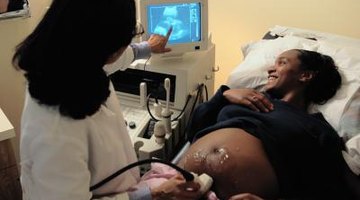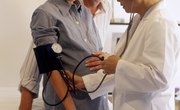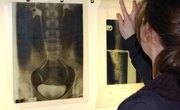Is it a boy or a girl? Is this a foot or a hand? Is that a smile? A pregnant mom’s ultrasound can be confusing to the untrained eye. However, a medical sonographer is trained in equipment that uses sound waves to show images of developing fetuses. That’s not their only job, though. Medical sonographers produce images of organs, tissues and blood to help diagnose diseases, as well. This profession requires extensive technical education in either a two-year associate or four-year bachelor’s program.
Getting Ready
Medical sonography students take background courses in medicine. Anatomy and physiology look at the structure and jobs of the body, such as the digestive, cardiovascular and respiratory systems. Lab work is part of this course and may include using cadavers to learn body parts. A class in medical terminology is required, where students learn the meaning of words, how they are used in a medical setting and how to pronounce them. This course helps them communicate with other health professionals. In addition, a cross-sectional anatomy course teaches students what “slices” of the human body look like, so they can recognize them during sonography.
Hands-On Experience
The first classes in medical sonography focus on the basic information, skills and techniques needed. In an introductory class, students become familiar with what normal organs look like, as well as common variations, such as kidney problems, liver disease and pregnancy. A physics and instrumentation class introduces students to how and why the sonograph instruments work. Students move on to study and practice how to use a sonograph for specific circumstances. Medical sonography is commonly used for pregnancies, obstetrics, gynecology and abdominal problems. For example, students will be able to identify normal development during pregnancy, as well as any problems that show up, such as spinal cord irregularities.
The Basics
Like most undergraduate programs, medical sonography programs have general education requirements. Students usually study general physics. For mathematics, students might need to take algebra and trigonometry or precalculus. All students must take liberal arts courses, including an introductory college composition class. Social sciences courses, such as psychology or sociology, are often part of the program.
Bachelor's Degree Bonus
Because the bachelor’s program is completed in four years, students have the opportunity to take more classes. Some of them are targeted for the major, such as genetics, vascular sonography, neurosonology and problem solving in sonography. Other courses are less specific but still science-oriented: biology, chemistry, medical ethics, statistics and research methods. Students also might have time for electives, either within the field or in a subject of their choice.
Related Articles
References
- Lorain County Community College: Diagnostic Medical Sonography
- RIT: Diagnostic Medical Sonography BS
- RIT: Bachelors in M.I. Courses
- Piedmont Virginia Community College: Diagnostic Medical Sonography
- MCPHS University: Diagnostic Medical Sonography-General
- Society of Diagnostic Medical Sonography: So You Want to Be a Sonographer
- ARDMS: Credentials & Examinations
Resources
Writer Bio
Living in upstate New York, Susan Sherwood is a researcher who has been writing within educational settings for more than 10 years. She has co-authored papers for Horizons Research, Inc. and the Capital Region Science Education Partnership. Sherwood has a Ph.D. in curriculum and instruction from the University at Albany.











